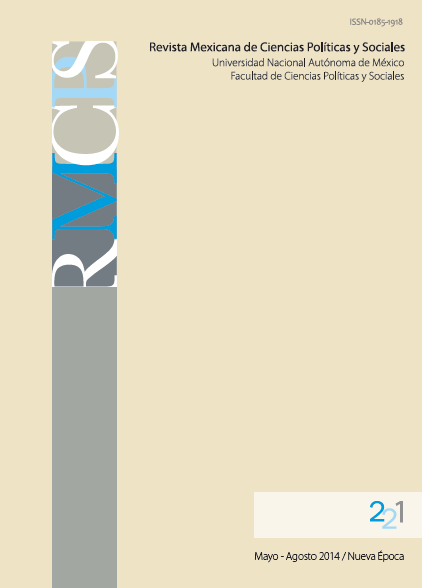The aleph of Memories and Ways of Documenting the Division of Korea in Contemporary Times
Main Article Content
Abstract
Downloads
Article Details
Citas en Dimensions Service
References
Álvarez, María del Pilar, (2007) “The Construction of Colonial Korea´s Memories through Contemporary South Korean Cinema. A Comparative Study of 2009 Lost Memories, Fighter in the Wind, Blue Swallow and Hanbando”. Tesis de maestría en Estudios Coreanos, Yonsei University GSIS, Seúl, Corea del Sur.
Álvarez, María del Pilar, (2013) “Las huellas de la colonización y el deber de la memoria: Apuntes desde el cine documental surcoreano” en Revista Estudios de Asia y África. Vol. XLVIII, núm. 2, mayo-Agosto. México, Colegio de México, pp. 381-410.
Álvarez, María del Pilar, (2014) “Memoria histórica e imaginarios de lo real: las relaciones Corea del Sur-Japón en el cine documental surcoreano contemporáneo. (2001-2010)”. Tesis de doctorado en Ciencias Sociales, Universidad de Buenos Aires, CONICET. Buenos Aires.
Bavoleo, Bárbara, (2009) “Sociedad Civil en el Proceso de Consolidación Democrática. República de Corea: 1995-2000” en Juan José Ramírez Bonilla (ed.), Transiciones coreanas. Permanencia y cambio en Corea del Sur en el inicio del siglo XXI. México, El Colegio de México, pp. 65-74.
Bhabha, Homi, (2011 [1994]) El lugar de la cultura. Buenos Aires, Manantial.
Didi-Huberman, Georges, (2004 [2003]) Imágenes pese a todo. Memoria visual del holocausto. Barcelona, Paidós.
Halbwachs, Maurice, (2011 [1950]) La memoria colectiva. Buenos Aires, Miño y Dávila Editores.
Huyssen, Andreas, (2001) En busca del futuro perdido. Cultura y memoria en tiempos de globalización. Buenos Aires, Fondo de Cultura Económica.
Jelin, Elizabeth, (2002) Los trabajos de la memoria. Buenos Aires, Siglo XXI.
Kim, Alejandro, (2011) “Introducción a los grandes debates dela historiografía surcoreana: en torno a los orígenes de la modernización” en Alcira Trincheri (comp.), Sexto Congreso Nacional de Estudios Coreanos. Neuquén, Educo, pp. 103-118.
Lavabre, Marie-Claire, (1998) “Maurice Halbwachs y la sociología de la memoria” en Raison Présente. Núm. 128, Octubre, pp. 47-56.
Lee, Chang Soo y De-Vos, George (comps.), (1981) Koreans in Japan. Ethnic Conflict and Accommodation. Berkeley/Los Angeles/Londres, University of California Press.
Lie, Jhon, (2008) Zainichi (Koreans in Japan): Diasporic nationalism and postcolonial identity. Berkeley, University of California Press.
Ryang, Sonia, (1997) North Koreans in Japan: Language, ideology, and identity. Boulder, Westview Press.
Lie, Jhon, (2000) Koreans in Japan: Critical Voices from the Margin. Londres y Nueva York, Routledge.
Lie, Jhon, (2010) Koreans in Japan: Critical voices from the margin. Londres, Routledge.
Shipper, Apichai W., (2010) “Nationalisms of and against Zainichi Koreans in Japan” en Asian Politics & Policy. Vol. 2, núm. 1, pp. 55-75.
Weinar, Michael, (1989) The Origins of the Korean Community in Japan 1910-1923. Manchester, Manchester University Press.
White, Hayden, (1992 [1987]) El contenido de la forma: narrativa, discurso y representación histórica. Barcelona, Paidós.
White, Hayden, (2010) Ficción histórica, historia ficcional y realidad histórica. Buenos Aires, Prometeo Libros.
En coreano
Jeong, Dae-ha, (2008) “Urihakgyo Kim Myeong Joon Kim Yong Gunsam” [Premio Kim Yong Gun por Nuestra escuela, dirigido por Kim Myeong Joon]" en The Hankyoreh. 22 de mayo-
Nam, Dae Un, (2007) “Uriuimugiryeokhantaedo, urihakgyo?” [Nuestra Escuela, nuestra letanía] en Revista Cine 21. 28 de marzo. Disponible en: <http://www.cine21.com/news/view/mag_id/45542> [Consultado el 3 de enero de 2014].
Literatura referida:
Borges, Jorge Luis, (2011 [1995]) El jardín de los senderos que se bifurcan en Ficciones. Buenos Aires, Debolsillo, pp. 103-117.
Sitios en Internet:
Asociación de Familias de Víctimas Raptadas por Corea del Norte: [Consultado el 20 de enero 2014].
Korean Film Archive: <http://www.koreafilm.org/main/main.asp> [Consultado el 20 de enero de 2014].

La Revista Mexicana de Ciencias Políticas y Sociales publicada por la Universidad Nacional Autónoma de México se distribuye bajo una Licencia Creative Commons Atribución-NoComercial-SinDerivar 4.0 Internacional.
Basada en una obra en http://www.revistas.unam.mx/index.php/rmcpys/
La RMCPyS autoriza a sus colaboradores que suban una copia de sus trabajos publicados en sus webs personales o en cualquier repositorio de acceso abierto, siempre y cuando se mencione específicamente a la Revista Mexicana de Ciencias Políticas y Sociales como fuente original de procedencia, citando el año y número del ejemplar respectivo y añadiendo el enlace a la página web donde este órgano editorial puede ser consultado in toto, de manera abierta y gratuita en: <www.revistas.unam.mx/index.php/rmcpys>.
Las y los lectores tienen libertad para:
Compartir, copiar y redistribuir el material en cualquier medio o formato.
El licenciante no puede revocar estas libertades en tanto usted siga los términos de la licencia.
De acuerdo con los siguientes términos:
- Atribución: la/el lector/a debe reconocer el crédito de una obra de manera adecuada, proporcionar un enlace a la licencia, e indicar si se han realizado cambios. Puede hacerlo en cualquier forma razonable, pero no de forma tal que sugiera que tiene el apoyo del licenciante o lo recibe por el uso que hace.
- No comercial: la/el lector/a no puede hacer uso del material con fines comerciales.
- Si se mezcla, transforma o se desarrolla a partir de la obra licenciada, no se permite la distribución del material modificado.
Cargos por gestión de artículos
La Revista Mexicana de Ciencias Políticas y Sociales NO cobra tarifas por recibir, procesar o publicar los artículos (Article Processing Charge [APC]) enviados por los autores.

